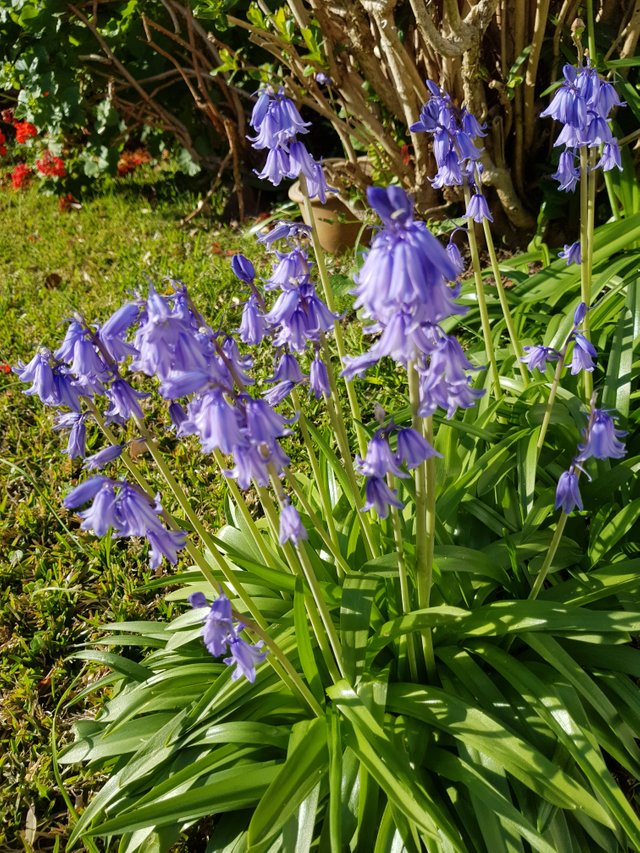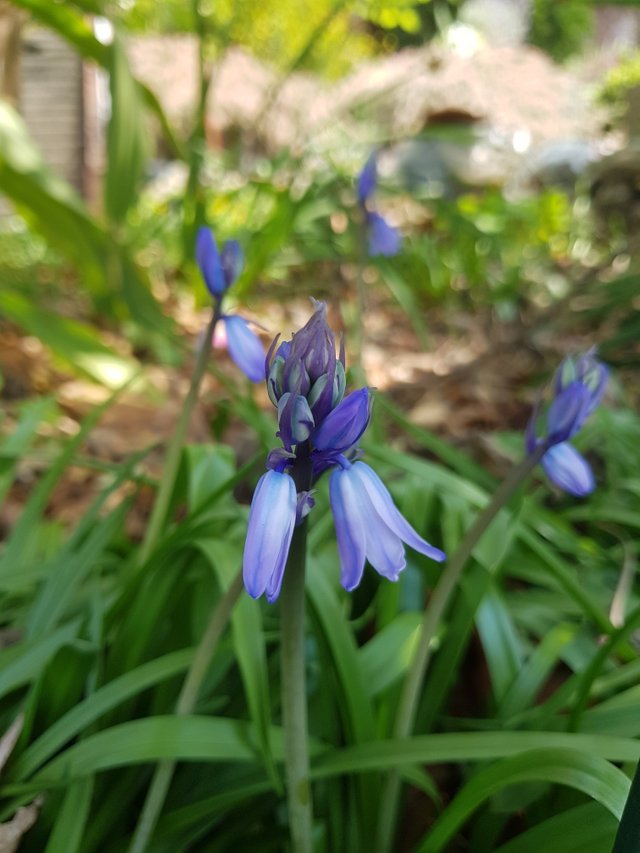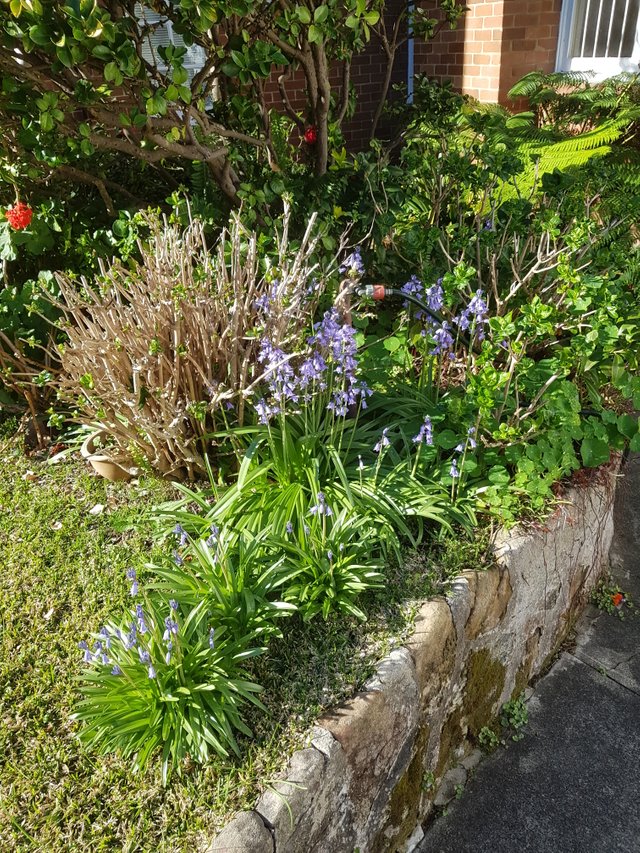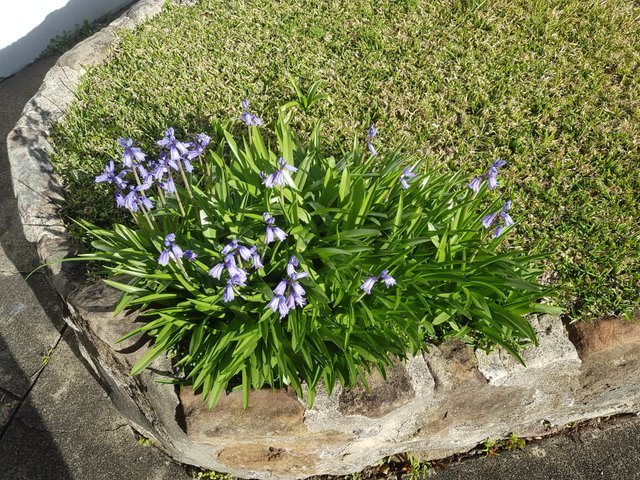Bluebells, you little beauty
Spanish Bluebells ( Hyacinthoides hispanica ) are a very popular choice for a spring-flowering bulb. The main reason is that they are easy to grow, even for time challenged or lazy gardeners... they are rarely affected by pests and diseases, and also deer and rodents don't enjoy their taste. Their pendulous flowers appear in Spring , rising above deep green clumps of shiny foliage, so they add charm to many garden spots. They are also happy in pots, and can be brought indoors for short periods. They are available in different shades of blue, and also in pink and white colours. There are other species of Bluebells with similar characteristics as these.
Bluebells are frost-tolerant to -20 degrees centigrade, and will be happiest in a temperate to cooler climate. Keep the soil moist where they are planted, and give them a position with semi-shade , or dappled sunlight under trees. I took these photos in a Sydney suburban garden. Some of these are growing in a lawn, so care has to be taken not to cut them off with the mower !



Also known as Wood Hyacinths, Spanish Bluebellls (Hyacinthoides hispanica) are charming additions to the spring garden. The pale blue, dangling bells complement yellow daffodils, red tulips, white lily-of-the-valley, and many other spring flowers.
Spanish bluebells are bulbous perennials native to Spain, Portugal and northwest Africa. Each bulb produces a clump of 2-6 strap-shaped leaves and a flower stem with 12-15 hanging, bell-shaped flowers. The plants are 12-18" tall. The bulbs are inexpensive, readily available, and easy to grow, so if you are new to bulb gardening, they are great plants to try.
Hardy in zones 3-8, Spanish bluebells will grow in full sun to part shade, and are not fussy about their soil requirements. They are good naturalizes, spreading both through bulb offsets and seeds. Here in New England, they will spread discreetly but steadily, making a cheerful community. Like other spring bulbs, they should be planted in the fall, and will bloom in early April to early May. The leaves will disappear as the plants go dormant for the summer.
http://www.enchantedgardensdesign.com/blog/2016/4/4/spanish-bluebells
Fav. comment Award ! Thanks for the great Pics.
Spanish bluebells are an easy-care spring-blooming bulb that does best in full sun (at least six hours of direct sun per day) or part shade. While they tolerate all-day shade, they don't tend to bloom as well. As the plants go dormant in early summer after they've leafed out, they're ideal for growing beneath deciduous trees like oaks and maples.
The best time to plant Spanish bluebells, like most other spring-blooming bulbs, is in early fall as soil temperatures begin to cool. These plants are not fussy about soil type, but they bloom best and spread fastest in a soil that's moist, well-drained, and rich in organic matter. Avoid soil that has a high clay content; in soggy soil they have a tendency to rot out and die over the summer.
https://www.bhg.com/gardening/plant-dictionary/bulb/spanish-bluebell/
Fav. comment Award !! Well done on your choice of Pics.
Spanish Bluebells (properly, Hyacinthoides hispanica) are best known for their pendent clusters of blue flowers, but there are also charming pink and white varieties available. Massed in a woodland or sprinkled through the perennial border, they mount a colorful and long-lasting display that will be repeated for many years to come. Not labeled. 25 bulbs cover 3 sq ft.
This small genus of spring-blooming bulbs from Europe and Asia is one of the most versatile and valuable because of its extraordinary willingness to prosper and bloom in sun to deep shade (some shade is required for satisfactory performances in the South). They thrive in a wide range of climates and well-drained soils, although a site with ample moisture early in the growing season is the key to abundant flowers. They will spread discreetly but steadily, making a cheerful community, then disappear by midsummer. Because Hyacinthoides are later bloomers, they are useful in the transition from early-spring bulbs to the first June perennials.
Find out from= https://www.whiteflowerfarm.com/310531-product.html
Excellent Pics, thanks !
Botanists now want us to call Spanish bluebells Hyacinthoides hispanica. But older names persist, including Scilla hispanica; they were also formerly placed in the Endymion genus. The package that you buy at the store may well be labeled Scilla campanulata -- yet another botanical name for the plant.
The scientific names of plants are supposed to make our lives easier as gardeners, giving precision where there would otherwise be chaos. Usually, they live up to their mission statement. Sadly, sometimes botanists have trouble figuring out what botanical name they wish to give a plant. The result is that older literature is littered with the rejected names, as the new name struggles to gain preeminence.
Plant height (and the number of flowers per stalk) will vary according to factors such as the size of the bulb. During the first year that you grow these plants in your yard, the tallest plant may reach 16 inches, while the shortest may stand around 7 inches high (these heights include the floral stalk). Size may diminish in subsequent years. The foliage is basal and sword-shaped, forming a clump.
Source: https://www.thespruce.com/spanish-bluebells-late-blooming-spring-bulb-2132115
Lovely Pics, thanks.
Hyacinthoides hispanica
Also known as the Wood Hyacinth or Spanish Bluebells, this invaluable 17th century heirloom has graced European woodlands for centuries. It has strappy, linear foliage and strong, 12" to 15", rigid, upright stems with 15 to 20 pendant, bell-shaped flowers in the most beautiful shade of shimmering blue-violet with darker, marine-blue midveins. Previously classified as Scilla campanulata Excelsior
Previously classified as Scilla campanulata Excelsior, it thrives in most soil and sunlight conditions, although it prefers a bit of light shade or dappled sunlight. Widely used in both naturalized woodland settings and display gardens, this deer- and rodent-resistant naturalizer matures over the years, becoming increasingly more substantial and prolific.


When it’s really happy where planted, it can naturalize by both bulb offsets (baby bulbs on the sides of the mother bulb you’ve planted) and self-sowing seed. Really mature clumps of Excelsior can stretch taller, up to around 20". They impart a special look and feel to woodlands: kind of like a magical cross between a Wizard of Oz garden and a midsummer’s night dream.
You’ll need about nine bulbs per square foot. (Square footage is determined multiplying the planting site’s length times its width.) In woodland settings, you can also scatter-plant the bulbs about for a more natural look.
Bulb size: 8 cm/up. Full to partial sunlight. Bloom time in horticultural zone 5: May. Plant 4" deep and 4" apart. Horticultural zones 3-8. Height: 12" to 15".

References12345
Silly Sausage Award !! Excellent Pics, thanks.
THank you so much!
@ctrl-alt-nwo,
I like the last photography most! They looks beautiful and like you said good for lazy gardeners like I do! I think I have some memories about this flower/plant at hill country of mine! Sometimes it might me a similar type of plant with that type of flower! Probably I took photography of them, due to attractive look of it! Nice photography and great description! Really appreciate your effort!
Cheers~
Shared on twitter promoting good quality content on #Steemit.
Stephen
#Promo-Steem #steemtalent #JoinSteemit #Steemit
https://twitter.com/StephenPKendal/status/1050068314783961088
Source
Spam is discouraged by the community, including comment spam.
More Information:
The Art of Commenting
Comment Classifications
Thanks again for the support !
It is a gorgeous flowering plant @ctrl-alt-nwo and also looks good to be put in any garden.
These are natural and stunning Bluebells wonderful to see them in your post today :D
Oh! I miss these purple bluebells! How I wish I could grow a carpet of purple bluebells in my garden! I used to walk in a forest full of bluebells long time ago!
This brings back very beautiful memory.
Posted using Partiko iOS